The N-body Shop Seattle Branch
The Formation of a Realistic Disk Galaxy in Lambda Dominated Cosmologies Final version! (Apr 04)
Authors:
F. Governato (UW, Seattle),
L.Mayer (Zurich),
J.Wadsley (Mcmaster, CA),
J.P.Gardner (U.Pittsburgh),
B.Willman (UW)
E.Hayashi (U.Victoria, CA),
T.Quinn, (UW),
J.Stadel (Zurich),
G.Lake (WSU)
ApJ in press. Significantly enlarged version.
We simulate the formation of a realistic disk galaxy within the
hierarchical scenario of structure formation and study its internal
properties to the present epoch. We use a set of smoothed particle
hydrodynamic (SPH) simulations with a high dynamical range and force
resolution that include cooling, star formation, supernovae (SN)
feedback and a redshift dependent UV background. We compare results
from a LambdaCDM simulation with a LambdaWDM (2keV) simulation
that forms significantly less small scale structure. We show how high
mass and force resolution in both the gas and dark matter components
play an important role in solving the angular momentum catastrophe
claimed from previous simulations of galaxy formation within the
hierarchical framework. Hence, a large disk forms without the need of
strong energy injection, the z = 0 galaxies lie close to the I--band
Tully--Fisher relation, and the stellar material in the disk component
has a final specific angular momentum equal to 40% and 90% of that
of the dark halo in the LambdaCDM and LambdaWDM models
respectively. If rescaled to the Milky Way, the LambdaCDM galaxy
has an overabundance of satellites, with a total mass in the stellar
halo 40% that in the bulge+disk system. The LambdaWDM galaxy has
a drastically reduced satellite population and a negligible stellar
spheroidal component. Encounters with satellites play only a minor
role in disturbing the disk. Satellites possess a variety of star
formation histories linked to mergers and pericentric passages along
their orbit around the primary galaxy. In both cosmologies, the
galactic halo retains most of the baryons accreted and builds up a hot
gas phase with a substantial X--ray emission. Therefore, while we
have been successful in creating a realistic stellar disk in a massive
galaxy within the LambdaCDM scenario, energy injection emerges as
necessary ingredient to reduce the baryon fraction in galactic halos,
independent of the cosmology adopted.
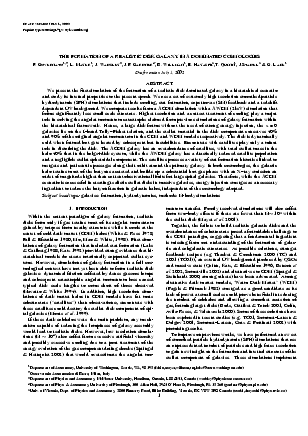 Get the
Postscript file (100kb)
Get the
Postscript file (100kb)
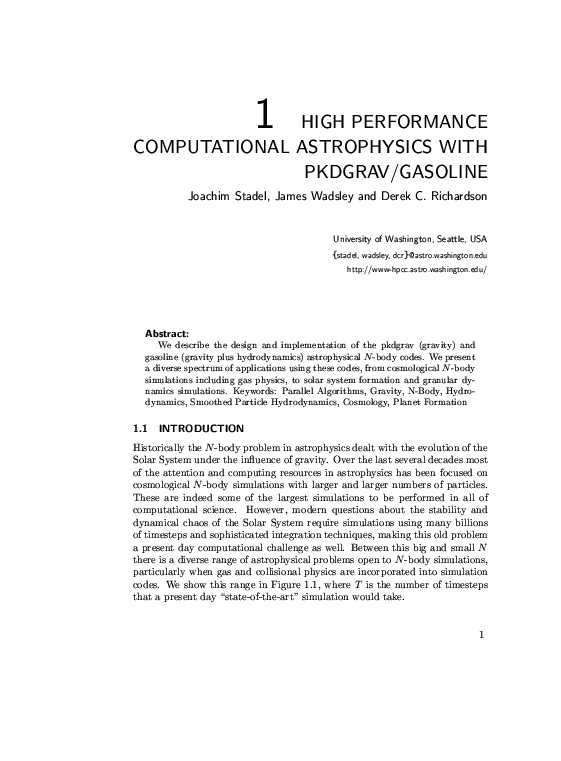 J. Wadsley, Thomas. Quinn and J. Stadel 2003. Gzipped Postscript file. Submitted to New Astronomy astro-ph/0303521
J. Wadsley, Thomas. Quinn and J. Stadel 2003. Gzipped Postscript file. Submitted to New Astronomy astro-ph/0303521
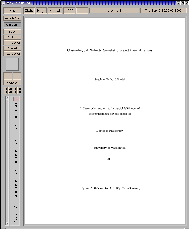 J.Stadel PhD Thesis. Chapters on PKDGRAV.
Gzipped Postscript file (1.6Mb)
J.Stadel PhD Thesis. Chapters on PKDGRAV.
Gzipped Postscript file (1.6Mb)
 Stadel, J., J. Wadsley, and D. C. Richardson 2002. High performance
computational astrophysics with PKDGRAV & GASOLINE. In
High Performance Computing Systems and Applications. (N. J.
Dimopoulos and K. F. Lie, Eds.), pp. 501--523. Kluwer Academic
Publishers, Boston. Gzipped Postscript file (2.6Mb)
Stadel, J., J. Wadsley, and D. C. Richardson 2002. High performance
computational astrophysics with PKDGRAV & GASOLINE. In
High Performance Computing Systems and Applications. (N. J.
Dimopoulos and K. F. Lie, Eds.), pp. 501--523. Kluwer Academic
Publishers, Boston. Gzipped Postscript file (2.6Mb)
Click on each small stamp to get the movie or a high res image
Movies are in Quicktime format. On Linux
you need Xanim or Mplayer.
With xanim: xanim +j40 file. All movies by Jeff Gardner. Go to his web site.
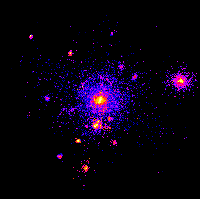 Formation of the stellar component in the LCDM model.
Formation of the stellar component in the LCDM model.
The movie is centered on the region were the galaxy forms and shows
only the star particles. Young stars are white and get red and then
dark blue as they age. Tidal stripping of the satellites originates the
halo component. You can see the disk forming at the center. Box is 650kpc (comoving) across. (60Mb)
 Age of the disk component in the LCDM model. Box is 40kpc across (40Mb)
Age of the disk component in the LCDM model. Box is 40kpc across (40Mb)
The movie is centered on the disk that forms in the LCDM run at z=0
and shows only the star particles. As we go backward in time (but we
keep positions fixed) stars that just formed are white and get red and
then dark blue as they age. You can distinguish the young thin disk
and the older thick disk. The oldest stars are in the bulge and in the
dwarf spheroidal that is currently passing close to the disk. Box is 30kpc across.
 The disk and bulge components formed in the LCDM cosmology.
The disk and bulge components formed in the LCDM cosmology.
Box is 40kpc across. The left panel shows stars formed after z=1.5, the right panel those formed before z=6.
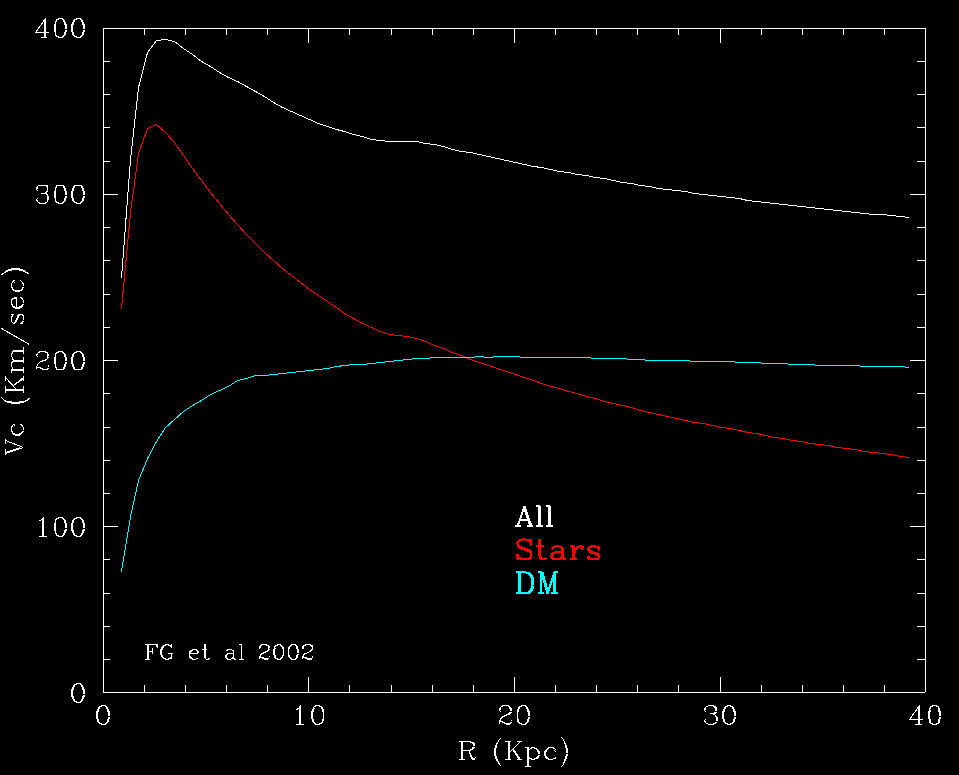
The rotation curve of the simulated galaxy.
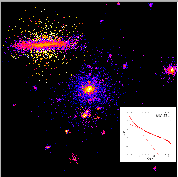
 Get the
Postscript file (100kb)
Get the
Postscript file (100kb)
 J. Wadsley, Thomas. Quinn and J. Stadel 2003. Gzipped Postscript file. Submitted to New Astronomy astro-ph/0303521
J. Wadsley, Thomas. Quinn and J. Stadel 2003. Gzipped Postscript file. Submitted to New Astronomy astro-ph/0303521
 J.Stadel PhD Thesis. Chapters on PKDGRAV.
Gzipped Postscript file (1.6Mb)
J.Stadel PhD Thesis. Chapters on PKDGRAV.
Gzipped Postscript file (1.6Mb)
 Stadel, J., J. Wadsley, and D. C. Richardson 2002. High performance
computational astrophysics with PKDGRAV & GASOLINE. In
High Performance Computing Systems and Applications. (N. J.
Dimopoulos and K. F. Lie, Eds.), pp. 501--523. Kluwer Academic
Publishers, Boston. Gzipped Postscript file (2.6Mb)
Stadel, J., J. Wadsley, and D. C. Richardson 2002. High performance
computational astrophysics with PKDGRAV & GASOLINE. In
High Performance Computing Systems and Applications. (N. J.
Dimopoulos and K. F. Lie, Eds.), pp. 501--523. Kluwer Academic
Publishers, Boston. Gzipped Postscript file (2.6Mb)
 Formation of the stellar component in the LCDM model.
Formation of the stellar component in the LCDM model.
 Age of the disk component in the LCDM model. Box is 40kpc across (40Mb)
Age of the disk component in the LCDM model. Box is 40kpc across (40Mb)
 The disk and bulge components formed in the LCDM cosmology.
The disk and bulge components formed in the LCDM cosmology.

